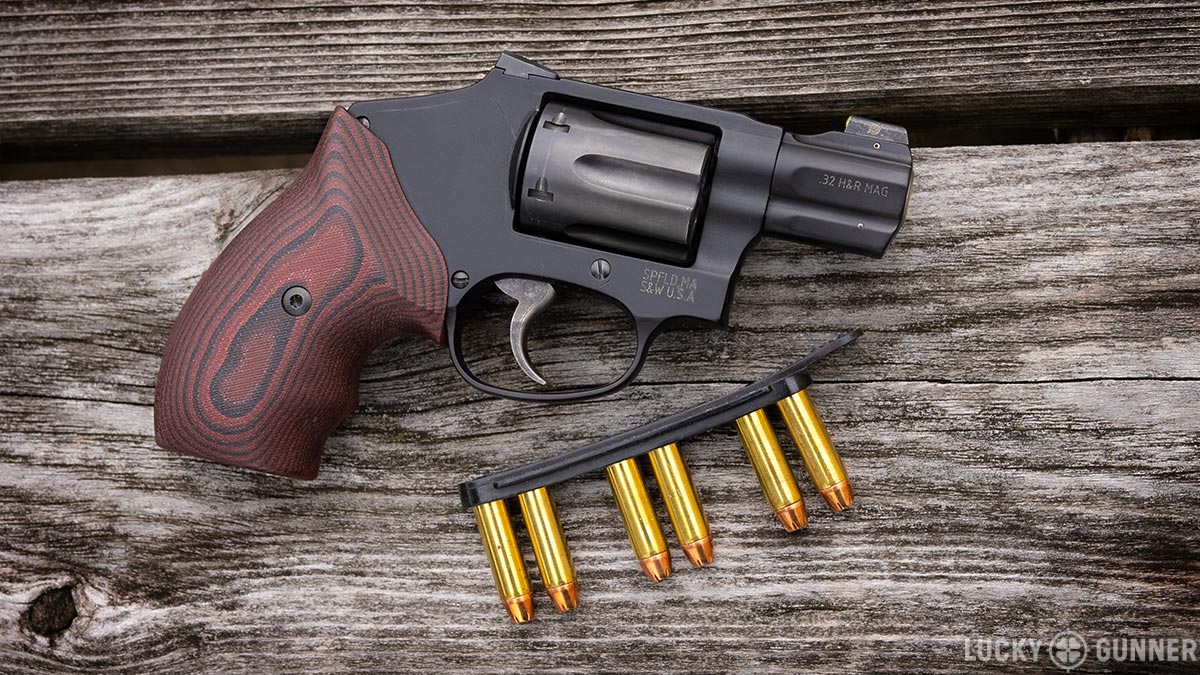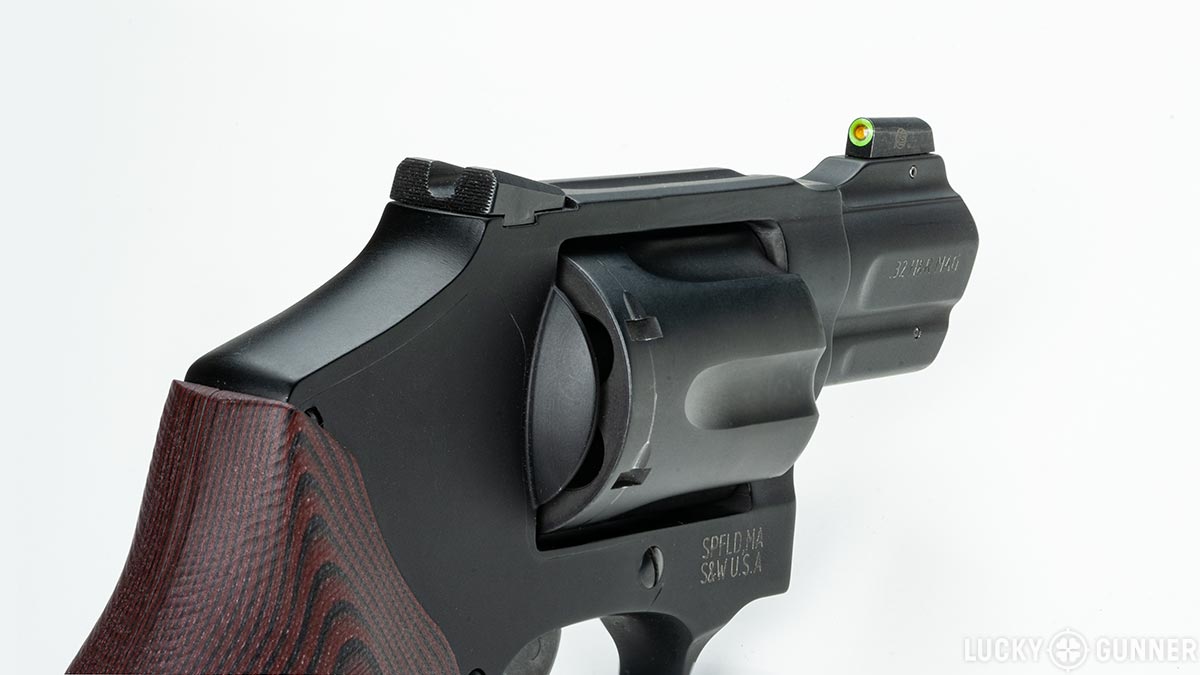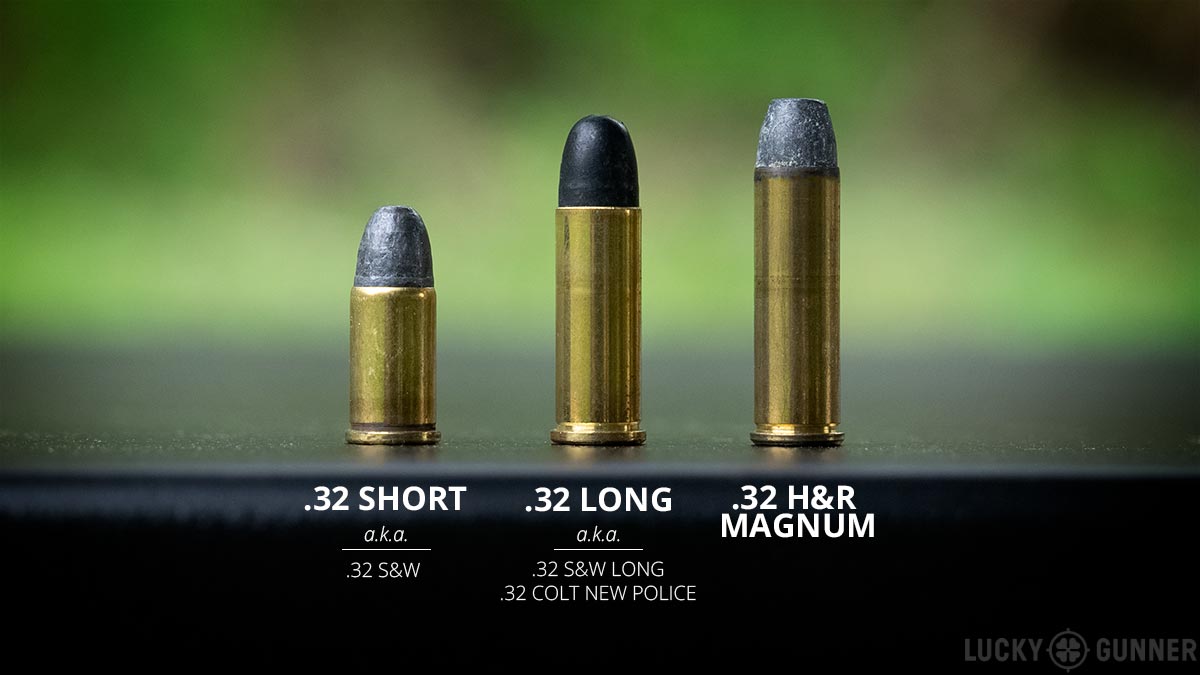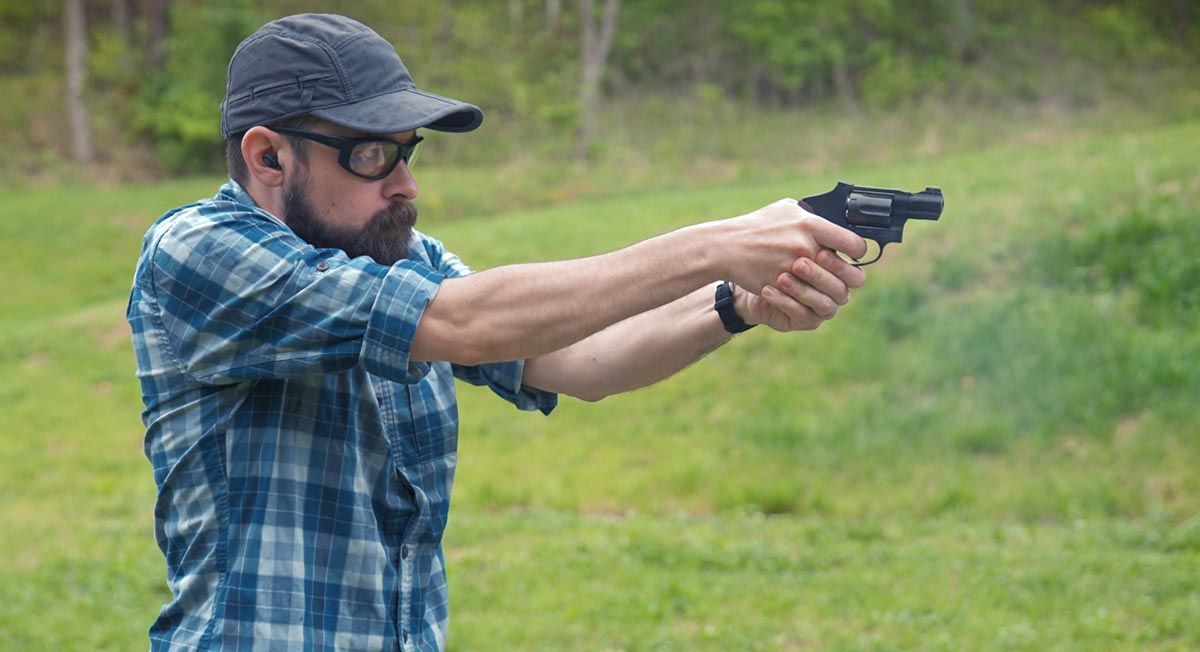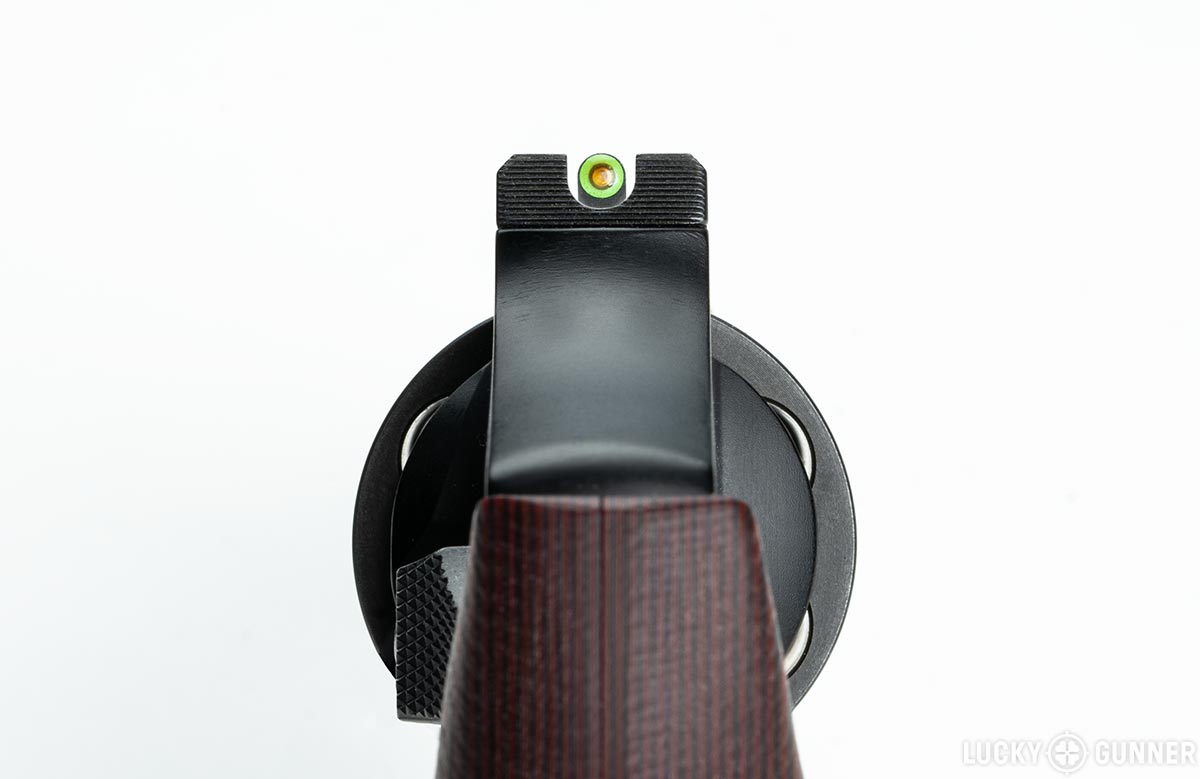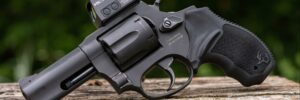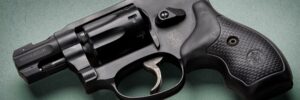More than 70 years after Smith & Wesson introduced their first lightweight hammerless snub nose revolver, they’ve finally released a version with modern sights, excellent grips, and a decent trigger. They’re offering it in .38 Special and (the criminally underrated) .32 H&R Magnum and it’s called the Ultimate Carry J-Frame. Let’s find out if it’s any good.
Details are in the video below, or keep scrolling to read the full transcript.
Hey everybody, I am Chris Baker from LuckyGunner.com and today I’m going to talk about the new Smith & Wesson Ultimate Carry J-frame revolvers.
These are offered exclusively by the firearms distributor Lipsey’s. They’ve got four models to choose from. A five-shot .38 Special or a six-shot .32 H&R Magnum. Both calibers have two finish options: a black finish with cherry grips or a stainless finish with gray grips. They are all based on the classic Smith & Wesson Airweight design – that’s an aluminum frame with a steel cylinder weighing 16.6 ounces unloaded. The MSRP for all four models is $759.
Lipsey’s loaned us a 432 UC for this review. That’s the .32 model with the black finish. It’s very similar to the gun I carry most days – an old Model 332 Ti which has been out of production for over 20 years. So I am square in the middle of the target demographic for this gun. But you guys know I’m not going to pull any punches. If this thing stinks, I’ll tell you. Fortunately, it does not. This is a really good J-frame. So let’s get into it.
This project started when Lipsey’s approached Smith & Wesson with the idea of a J-frame with features that serious defense-minded shooters have asked about for years. They got input from Darryl Bolke and Bryan Eastridge – a couple of guys who possess a deep understanding of the fighting revolver. So this is not just marketing hype. The Ultimate Carry project is a legitimate attempt to offer the best J-Frame possible.
Smith & Wesson has been making J-frames since 1950. They’ve produced hundreds of variants over the years. There are no fewer than 38 different J-frames in their regular catalog right now. I would not blame you for being tempted to ignore this one because… what could they possibly do with this gun that hasn’t already been done?
Sights
Well, one thing they’ve never done before is put decent sights on a lightweight model. They’ve done proper sights on a steel gun like the 640 Pro, for example. It’s an excellent shooter but it’s an all steel gun and weighs over 22 ounces. It’s not quite as convenient to carry as the Airweight and AirLite models.
For those guns, Smith has occasionally stuck a fiber optic tube or a white dot on the front, but usually it’s the traditional ramp sight. And they all have the basic shallow trench in the top strap for a rear sight.
So the stand-out feature of the Ultimate Carry J-frame is the sights. In the front we have a pinned XS night sight. It’s a tritium vial with a bright neon green ring around it. The black serrated U-notch rear sight sits in a (windage adjustable) dovetail cut.
Normally, I am not crazy about U-notch rear sights or round-profile front sights. It’s challenging to get a really precise sight picture with them. For a J-frame, I don’t care. I just want something I can see. These are as easy to pick up as the sights on a full-size duty pistol, and that, alone, makes this gun a lot more usable than the standard off-the-shelf J-frame.
Why .32 H&R Magnum?
Personally, I’m just as excited about the fact that they’re offering this gun in .32 H&R Magnum. Before this year, no revolvers in that chambering had left the Smith & Wesson factory since 2005 (unless you count the small batch of 327 Federal Magnum J-frames they did in 2009).
I can’t really be mad at Smith for having neglected .32 H&R Magnum. It’s not a popular cartridge. When I picked this gun up, the younger guy behind the counter said he had never even heard of it before. And that’s really a shame. The only reason .38 Special became the default snubby cartridge is because cops wanted to use the same ammo they had for their duty guns. For the armed citizen today, .32 just makes a lot more sense in a lightweight revolver.
I won’t try to sell you on it today. You can just go watch the video I did a while back called “Why the Best Snub Nose Caliber is .32”.
Actually, since you’re already here, I am gonna try to sell you on it. Basically, you get six shots in the cylinder instead of five. With a 2-inch barrel, the ballistics are similar to .38 Special, but with around 60-70% of the recoil. Maybe even less, depending on your ammo choice. Models chambered for .22 LR or .22 Magnum are also viable low-recoil alternatives to a .38. But because of the way rimfire ammo is designed, those revolvers always have heavier triggers. A .32 gives you low recoil and the less heavy trigger of a centerfire model.
The only downside is the cost and availability of ammo. Most stores don’t carry it so you pretty much have to order it online, and even then, the selection is limited. .32 H&R Magnum is almost never less than a buck per round. But you can also fire .32 Short and .32 Long out of these guns. .32 Long, in particular, is relatively plentiful and reasonably priced – not like the mainstream calibers, but it’s also not going to bankrupt you to buy a few hundred rounds.
It used to be a very popular cartridge in the US. There are millions of revolvers out there from the 20th century chambered for .32 Long. It’s still fairly common in other parts of the world. The ammo companies are not going to abandon it any time soon. So you can practice with .32 Long and carry .32 Magnum. The magnums have a little more recoil, but they feel more like a .32 +P. It’s not a huge leap in recoil like .38 to .357.
If you’re still not sold, that’s okay. That’s why the Ultimate Carry J-frame also comes in .38 Special.
Grips
Okay, there are a lot of other features here, so let’s keep moving. The grips: they are made from G10 by VZ Grips. G10 is a lightweight fiberglass composite material. I’m very impressed with these grips. They’re wide enough to get a solid grip but short enough to conceal easily.
VZ makes several other grips for J-frames, but these were designed specifically for the Ultimate Carry J-frame. There’s no checkering or any other aggressive texture. They’re smooth, but not slick like lacquered wood. The left side is relieved a bit for using speed loaders. They are a boot grip design, meaning the bottom of the grip panels is flush with the bottom of the grip frame. They also wrap around the backstrap, which I really appreciate because that increases the trigger reach just the right amount for my hands.
It’s a “high horn” design – this back portion goes all the way up to the top of the backstrap. A lot of grips stop right here at the cylinder latch. That means your firing hand thumb often ends up riding right on a hard edge. You can see here on these Crimson Trace grips, which I really like in general, they stop a little too low and the rubber has started peeling away because my thumb rests right on top of this top corner. Not an issue with these grips here. They also fill in this area here behind the trigger guard – that’s a detail that a lot of other J-frame grips don’t get quite right.
Of course, grip fit is a very subjective thing. But if you fall somewhere close to the middle of the bell curve for hand size, I think these will work pretty well for you.
Trigger
No J-frame treatment would be complete without some attention to the trigger. The marketing copy says that Smith & Wesson has “optimized hammer & trigger geometry and springs for a lighter, smoother trigger pull.” I don’t know exactly what they mean by optimized geometry. But this is a bit lighter and smoother than a standard J-frame. It’s not as light as some of the Performance Center J-frames I’ve handled in the past. It’s also not quite as light as a J-frame with the Apex trigger kit installed.
J-frame triggers also tend to vary a bit from one sample to the next, so I don’t know how this one might compare to other Ultimate Carry models. If you get one of these and it’s not as smooth as you’d like, maybe try the Apex kit, or just dry fire it a bunch and it should smooth out to be at least a decent trigger.
Other Features
Okay, so sights, grip, trigger. Those are the areas where a snub nose typically has the most room for improvement. But they’ve added a few additional touches like chamfered charge holes. That’s where there’s a slight bevel on the inside edge of each chamber. It helps the cartridges slide in there a little easier, especially when you’re using wadcutters.
The front of the cylinder is also beveled. That’s not something you’re likely to notice much if you use a kydex holster, but for something like a snug-fitting leather holster, the bevel helps the gun slide into place a little easier.
And lastly, they’ve made some durability improvements – specifically, the pins that hold the gun together are now titanium instead of the usual aluminum.
The Ultimate Carry J-Frame at the Range
I put about 500 rounds through this gun at the range – a mix of .32 Long and Magnum. I don’t have a whole lot to report. It worked. Recoil was tame, as expected.
According to Lipsey’s, the sights should hit point of aim with .32 H&R Mag Federal 85-grain JHP or .32 Long Buffalo Bore 100-grain wadcutters. We didn’t have any of the Federal load to test, but I confirmed the zero for the Buffalo Bore. In fact, the sights were pretty much dead-on for all of the six loads I tried. There was some variation in point of impact, but at 15 yards, if I covered the center of a B8 bullseye target with the front sight dot, I could keep nearly all of my shots in the black, regardless of the ammo.
If you’re more interested in the .38 version, those sights are regulated for 135-grain +P Gold Dot and 148-grain lead wadcutters. That’s a small but important detail. A lot of .38s will only hit point of aim if you use 158-grain loads. But wadcutters and Gold Dots are favorites among snub nose aficionados, so that’s a much better zero.
I did a lot of work from the holster and shot several drills with this gun. Without a doubt, these sights are far superior to not only the standard j-frame sights, but probably the factory sights on any other small frame revolver on the market.
The grips exceeded my already high expectations. They’re thicker and fill my hand better than most grips. It’s easier to get a more consistent grip on the gun out of the holster. The G10 material lets you make micro corrections to your grip as you’re getting on target. That’s one of the reasons I like G10 grips on full size revolvers. Rubber is nice for a little recoil mitigation on the smaller guns, but that’s not really necessary with the .32.
Old vs New
I don’t know if the 432 UC will replace my old 332 Ti as my everyday carry gun. The 332 has a titanium cylinder, so it’s about five ounces lighter. And the trigger is nice and broken in. It’s right where I want it for a J-frame. But I could really go either way. If I had to switch to the 432 for some reason, I wouldn’t complain at all.
Carrying a small revolver in 2024 is not for everyone. They tend to make the most sense for people at opposite ends of the skill curve – either the relatively inexperienced, or well trained and skilled shooters. The Ultimate Carry J-frames have features that shooters in either category will appreciate. They are definitely worth considering.
I hope you guys enjoyed this review. If so, do me a favor and the next time you need some ammo, be sure to get it from us with lightning-fast shipping at LuckyGunner.com.


